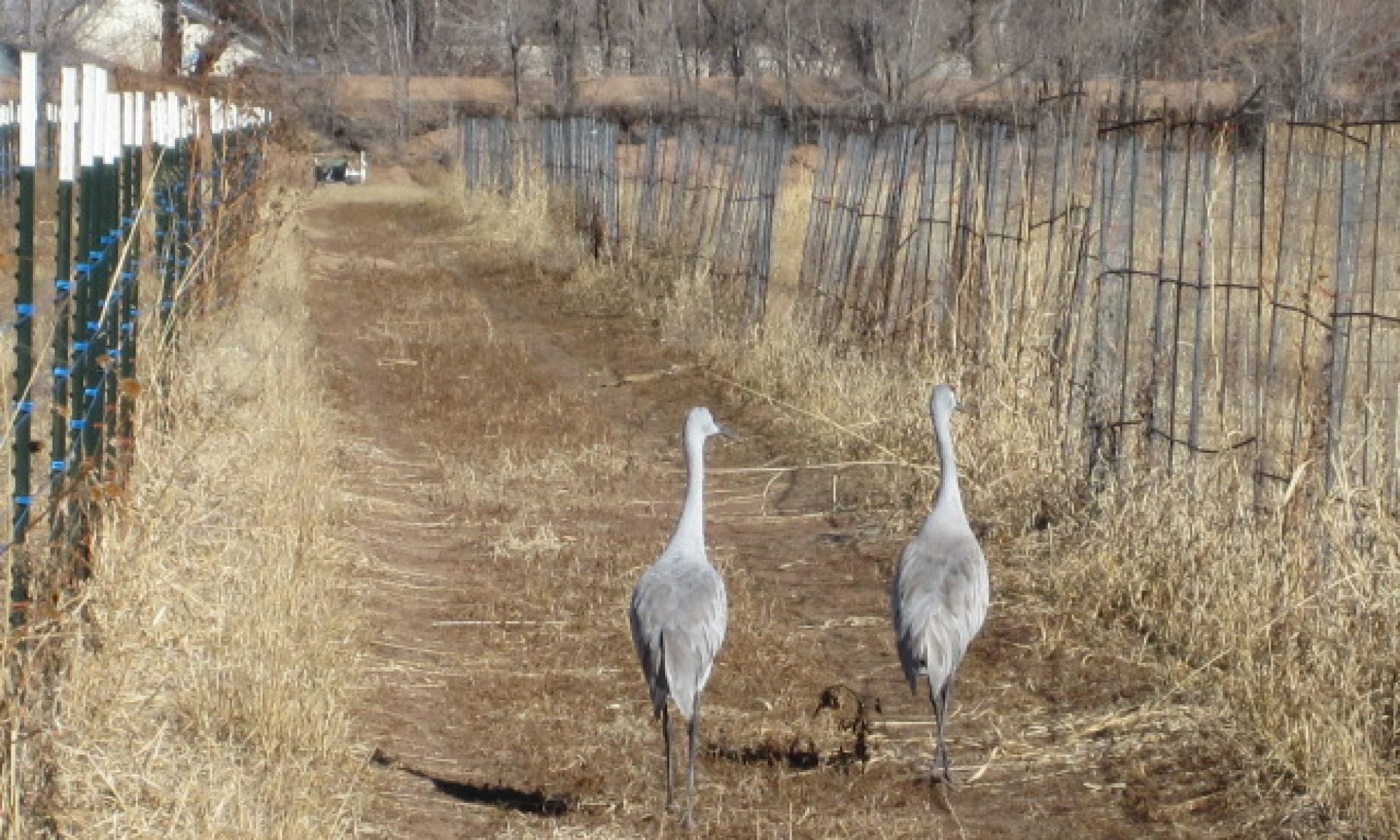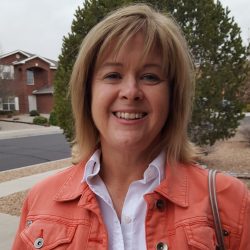One morning in July, Rusty nudged me out of bed at 6:30, amazed as always to have woken into another wondrous day. There were squirrels to see, bunnies to yearn for, birds to bark at. His whole body was wagging. How could I still be in bed?
I pulled on shorts and a t-shirt, slid my flip-flops on, and out we went into what passes for Eden. The air was cool, a good twenty degrees below the nineties we’d reach later in the day, and everything was moving.
Cottonwood fluff landed on my eyelashes; finches and cowbirds danced and dipped and dove. Trees quivered, a dotted line of ants marched crumbs across the sidewalk, and neighbors on their way to work waved from their cars. Rusty, beside himself in the brand new world, could hardly keep his paws on the ground.
At the far end of the street, high up in the cottonwood by the mailboxes, the neighborhood hawks are raising another family. The eggs have hatched and the birds are staying close; this morning one watches from the wall at the top of the hill while the other flies low overhead, gripping a doomed lizard. Tiny bits of bone and feather and fur litter the ground under the nest.
I was starting to think that maybe I would write about motion when I started noticing things that were standing still. I looked at the mesa, the Sandias tugging the sun over the crest, the thick trunk of the cottonwood I leaned on while Rusty sniffed and pawed at the ancient earth.
That was a few months ago. These days Rusty is sleeping later. Summer’s bright promise slid into golden fall, and I keep sorting the world into two piles: things that move, things that stay still.
I’m in my seventeenth year of teaching high school. I started in 2001, just before the Twin Towers came down. I was driving to work when I started hearing the story on NPR. When I reached my classroom, students were already crying. I remember saying something stupid, something to suggest that when we learned all the facts, things would somehow be ok, less terrifying than they seemed in those early hours and days of not knowing. Of course, that wasn’t true.
That day provided some of my earliest lessons in how to be a teacher. Understand that you don’t have what they need. Hold a space where they can cry. Try to be just a little bit stronger than they are, unless it’s one of those moments when they need to know it’s ok to be weak. Be grateful for structure; in a chaotic day, it can help to head off to chemistry class just because it’s 9:35.
Because I started teaching at this precise historical moment, my life divides neatly into before and after, just as in so many ways, the story of this country does. Because I started teaching at this precise historical moment, my work as a teacher has always been tied to my hopes and fears for the world.
Seventeen years isn’t as long as some things. It’s shorter than the time my sister Meg has been dead. It’s shorter than the number of years I’ve been married. It’s shorter than the number of years my parents lived on Marvle Valley Drive.
It’s longer than the lives of the students I am teaching now. When I started my life as a teacher, most of my students weren’t born. The students I taught in those magical early years are married, have children, lament on Facebook that they feel old.
My current and recently past students are in motion. They grow, they graduate, they move away, they come back. “How are you?” they ask me when they stop by on winter break. “What’s new?” Fine, I tell them. Nothing much, I tell them. I am still here. Some of them, I know, find this comforting, this returning to your past and finding your old teachers still mucking around in it.
Last week The Birds of Chicago spent the week in residence at my school, making music for and with us. These people who tour over two hundred days a year taught classes, made us laugh, and yanked our hearts right out of our chests. We laughed and cried together while our hearts flopped around on the outside like fish at play in this crazy new thing called air. On Thursday morning after they played with our jazz band, I found myself talking to a colleague. “I want to go back and make every decision differently,” I heard myself say. Then the day took off as the days in a school always do, and I didn’t give it much more thought.
Do you know how, when you pray or meditate every day, answers to questions you haven’t even figured out how to ask appear fully formed in your head? Well, I haven’t been meditating every day, but I have been trying to write most days and to take a few deep, intentional breaths now and then, and, wham, somewhere mid-afternoon the answer to a question I didn’t know I’d asked popped into my head. “Do nothing safe,” it shouted, as though it was afraid I wouldn’t hear.
What the hell, universe? I’m fifty-three and ten twelfths years old. I’m healthy-ish, but that’s because I’ve got good health insurance that pays for one of those expensive drugs that flowy-haired women on horseback advertise on tv. I live in a beautiful, paid-for home in a marriage that works pretty well most days. I can afford to take violin lessons with my granddaughter and pay for the gym membership that keeps my joints moving. Sure, it would be nice to have a bigger number in my 401K, but I can’t really think of a different number that would make me stop thinking that. My only real gripe is that, when I read that the average age of menopause was fifty-one, I took it as a promise. That hasn’t really panned out for me.
So what’s up with envying people who spend two hundred days a year on the road, and what does the universe mean when it tells me to “do nothing safe”?
The next day I’m talking with my friend Nina who tells me about her friend the successful entrepreneur. His motto is “Think short term and rely on good luck.” It sounds like a prophecy, so I write it on a notecard and tack it to the bulletin board in my classroom. It’s terrible advice for teenagers, but I can’t bring myself to take it down.
So. October is sweeping the floors, getting ready to close up shop. November is dusting off the shelves, hanging the grand opening signs. I hear the cranes have come back. I haven’t seen them yet, but I believe they are here. The sycamore in the back yard is gold and going bare. The plum in the front is still green and going red. Some things are moving. Some things are standing still.
The problem is that I can’t figure out which one I am doing. On any given day I love my work. I love standing like a ledge, or a rock, or a launchpad in my students’ lives. On any given day I’m background noise or a faint breeze. On any given day I support or chastise or applaud while my heart swims out beyond my body and back again, over and over.
Those early lessons about teaching still hold. Just this week I’ve had students who needed strong, and students who needed to know it was ok to be weak. Just this week, I’ve held a place for them to cry. Just this week, I’ve realized for the millionth time that I don’t have what they need.
The problem is, lately I can’t figure out whether I’m living out my calling or avoiding it. Something is moving in me, stretching at my seams.
Maybe it’s just my body’s stubborn refusal to quit producing eggs, or all this Halloween candy, or another chronic illness come to swell my joints. Whatever it is, when it reveals itself, I hope I’m paying attention. I hope I will remember to do nothing safe. I hope I will remember to think short-term and rely on good luck.
I’ll keep you posted. In the meantime, you might want to check out The Birds of Chicago.
*****************************

